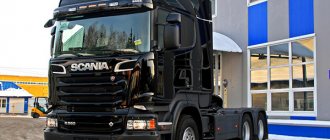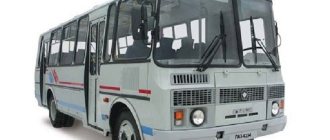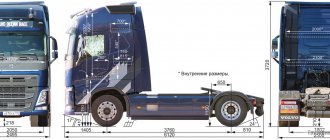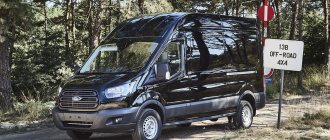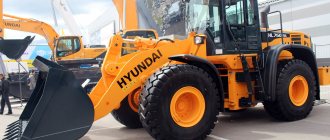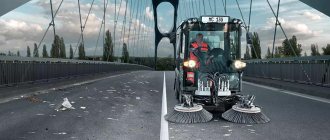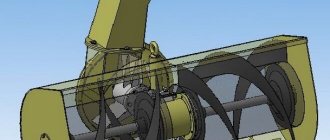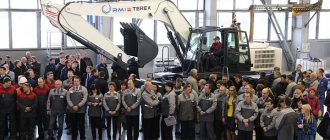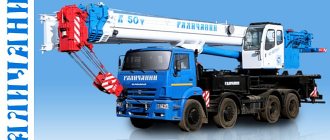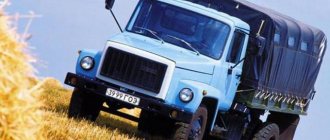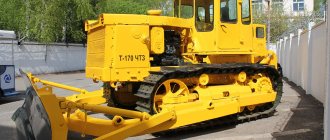Iveco Stralis Hi-Way AS440S46 4×2 TP RR is produced on the assembly line of the company from Italy Iveco SpA The debut of the Stralis model was marked in 2002. The main tractor differed from its predecessors and competitors in that it was equipped with an automatic transmission as standard. Buyers and critics praised the Stralis, which allowed it to receive the title of best truck of the year in 2003. Over the following years, the model was constantly updated. In 2007, the cabin was radically changed, making it very spacious. In 2012, Italian automakers carried out a complete modernization, which allowed the Iveco Sttralis Hi-Way to become the best truck for 2013.
"Iveco Stralis": the path to Russia
The main thing is that the majority of European-made long-haul trucks came to Russia not in new, but in used form. And in those years when used “Germans” and “Swedes” were purchased en masse by our consumers, the first generation Iveco Stralis were still young and, therefore, expensive. plus, in subsequent years, it was necessary to travel for used cars of this brand not to Germany, but to Italy or Spain, where they are quite widespread. But this was not accepted - why, if Germany is only 2 days away?
Potential consumers from Russia have developed a distrustful attitude towards the quality of the Stralis of the first two generations of production, against the backdrop of the impeccable reputation of the well-known and tested Volvos, Mercedes, MAN, DAF. However, several years later, even Quite large transport enterprises began to purchase Iveco Stralis mainline tractors not in isolated cases, but in whole batches, forming their fleet mainly from them. A more attractive price and, in general, successful operating experience still played a role.
No time for fat
Why is there such a craving for average, and not for the “very best”, “top”, “advanced” performances? I'll tell you. One of the truck salesmen, who works with solvent corporate clients, recently shared with me the most common approach, which has become something of a trend in recent years.
It looks something like this, of course, somewhat exaggerated.
Phone call.
– Tell me, are there any completely “empty” basic vehicles in stock or in upcoming deliveries?
– We can deliver, but we still need to clarify the list of equipment.
- What kind of equipment is there...
– But you won’t be happy with a car, say, that doesn’t have a steering wheel!
– So we’ll take it, and we’ll just order the steering wheel as an option!
...the interior matches it: the rather compact dimensions of the cabin do not at all limit the comfort of its inhabitants
If, understanding the reasons for this approach, you dig a little deeper, then two “strings” appear that lead to the truth. The first is, of course, the shortage of funds in the transportation business, the second is that the basic equipment of today’s main line is such that it often covers the necessary and sufficient needs of the average carrier. So people don’t want to overpay for something they don’t need. And with each new product, I become more and more interested in how it will be equipped and how much they will ask for it all, but within the framework of reasonable, and not endless financial horizons.
What do the heads of motor transport companies say about Iveco Stralis?
By the way, a significant share of the all-Russian Iveco Stralis vehicle fleet, according to the same Autostat data, belongs to the North-Western District - two thousand tractors. From this, as well as from the reviews of the St. Petersburg owners of the Stralis, we can conclude that the Italian can work successfully in the harsh northern climate. Data from surveys of managers of motor transport enterprises indicate that those who became closely acquainted with long-haul tractors from Iveco back in the mid-2000s continue to remain faithful to this model. This says a lot.
ATK-Northern Capital LLC, St. Petersburg
In particular, Sergei Lysy, General Director of ATK-Northern Capital LLC, St. Petersburg, said that he and his partners first became acquainted with Iveco Stralis machines in 2006-2007. These were used trucks purchased in Europe with robotic gearboxes.
To date, the mileage of these oldest ones has already exceeded a million kilometers. And so far, none of them have required major repairs after natural wear and tear. Although there were isolated cases of power unit failure due to oil starvation, the cause of which was the notorious “human factor”.
Having evaluated the new model, a couple of years later the company purchased a batch of new Iveco Stralis, already from the official dealer of the corporation. Most of them are also “in service” and bring a stable profit without requiring major repairs. A year ago, three new generation tractors were purchased - Iveco Stralis Hi-Way.
All of the named cargo tractors work with container semi-trailers, delivering cargo throughout Russia. Diesel fuel consumption is moderate, from 28 liters per 100 km. The clutches on some cars lasted 700 thousand km. Gearboxes and drive axles do not cause any problems - these units need to be repaired very rarely, as a rule, with a mileage of more than 500 thousand km.
Among the weak points in the design, Sergei points out the four-circuit protective valve of the pneumatic system, which begins to poison the air and periodically needs to be replaced.
RusTransLine LLC, St. Petersburg
Dmitry Beschastnov, director of St. Petersburg LLC RusTransLine, said that Iveco Stralis gradually became the main transport unit in their company’s fleet: out of forty-five mainline two-axle tractors with three-axle tilt semi-trailers, 35 are Iveco Stralis. The main routes are to Finland and back, but there is also cargo transportation within Russia.
Initially, the choice of brand, as Dmitry notes, was dictated by the attractive price, in comparison with the cost of MAN tractors, which the company's owners previously preferred.
Now the mileage of the oldest in RusTransLine has reached 800 thousand kilometers. There are also “fresh” ones: the six newest cars in the company are the latest Stralis Hi-Way model. In general, Dmitry and his colleagues are satisfied with the reliability and durability of Iveco Stralis tractors - “problems with the engine occurred only on vehicles purchased in 2007-2008.”
Over a run of about 150 thousand kilometers, oil consumption due to waste increased significantly due to wear of the piston group. The reason was the plant’s use of piston parts from the Euro-5 engine variant in Euro-3 class power units. It is typical that after contacting the dealer, she corrected her mistake by replacing the piston groups on the trucks with parts from the Euro-3 version.
The clutch, according to Dmitry, “goes” 500-550 thousand kilometers. The turbocharger on the Stralis serves the same amount of time. Most of the other replacement parts are planned: filters, pads, brake discs, repair kits for kingpin units, etc. consumables.
There were unscheduled minor repairs to electrical equipment - it happens that contacts corrode in winter, sensors fail. We also had to replace the gear shift lever joint when noticeable play appeared due to wear.
The company installs cheap Chinese tires on the drive axles of tractors and semi-trailers (for example, “Aeolus”). On the front axle, more expensive ones are used - “Continental” or “Dunlop”.
OJSC "SovInterAvtoServis", Moscow
Logistics Director of the capital's SovInterAvtoServis OJSC Sergei Logunov shared the following information. In total, the company's fleet includes about seventy large-capacity long-haul tractors (couples with tilt and isothermal semi-trailers). And most of them (36 units) are occupied by Iveco Stralis cars produced in 2008-2011.
All these machines are equipped with Cursor-10 engines of environmental standards from Euro-3 to Euro-5, with various power settings, equipped with fuel equipment with pump injectors. Vehicles are used to transport a wide variety of goods throughout Russia and the CIS.
Sergey estimates the average consumption of Stralisov diesel fuel at 30-32 liters per 100 km, depending on the specific load values. He did not highlight the problem components of this model, noting that with proper care, the Iveco Stralis works for years without requiring major repairs.
Also notes the wear resistance and durability of consumables. For example, a clutch lasts at least 250 thousand kilometers. And for careful drivers, it “goes” even for much longer distances). Front brake discs last about 300 thousand km, pivot units - approximately 400 thousand km.
Exterior and interior
“They don’t make ugly cars in Italy!” – said Alfredo Darrico, head of the IVECO representative office in Russia. And I couldn’t help but agree with him! Mentally going over in my memory all the products of the Italian automobile industry that I was familiar with, I came to the conclusion that, with rare exceptions, most of them are unique standards in the world of automotive design, both passenger cars and trucks, both interior and exterior. The new IVECO Stralis continues this proud tradition. I’ve sung the praises, now I’m fleshing out the details.
I would call the exterior and interior design of the car organic. I think it was not easy for Italian designers and designers to achieve such a result within the existing budget. The on-board computer with a multi-color display fits neatly into the center of the classic instrument cluster, which would decorate not only a truck, but also a mid-budget passenger car. The gearbox lever console placed the parking brake valve next to it, creating a specific “thematic” working area for the driver. Despite the modest internal dimensions and impressive engine tunnel, there was room for two full-size “sleeping bags”, and the standard set of panniers pleased with pleasant plastic and clear operation of the locks. The seats, both left and right, are comfortable and simply pleasing to the eye, sometimes even causing slight associations with elite supercars. The impression was complemented by weightless doors with perfectly adjusted and silent locks. But that’s what the world fame of Italian automotive design is for! The only thing that simplified their (designers and technologists) task was the cabin frame, which did not fundamentally change in relation to the previous model. The new IVECO Stralis cannot be faulted for its recognition. Moreover, there is a cunning marketing ploy: without a careful study of the details, the flagship Hi-Way and the budget HI-Road are very difficult to distinguish.
About the history of the model. Types and modifications of "Iveco Stralis"
The first generation Iveco Stralis long-haul tractor debuted in 2002, and for the first year it was produced only in a “long-range” version - with a large double “Active Space” cabin. The family was later expanded to include options for regional and local transport. With narrower, shorter, low-roofed and sleepless Active Day cabs. And also the “Active Time” type (with a berth, but a low or medium roof height. Their chassis is the same as that of “long-range” tractors.
"Iveco Stralis" first generation.
But, expanding the capabilities of this chassis for superstructures with various bodies, potential consumers began to be offered various options for wheel formulas - in addition to 4x2, also 6x2 and 6x4. Iveco Stralis assembly plants were deployed at the company’s factories in Ulm (Germany) and Madrid (Spain).
The turn of the second generation Iveco Stralis came in 2007. Restyling and modernization then affected mainly the design and interior. The Active Space cabin received the additional name “Cube” and became much more spacious. The shortcomings in the design of the main systems and components were also taken into account - the Stralis of the 2007 model was partially freed from “childhood diseases”.
"Iveco Stralis" second generation.
The third generation was introduced in 2012. Again, the main object of improvement was the cabins, which received different names: “Hi-Way” - instead of “Active Space”, “Hi-Road” - for regional transport, and “Hi-Street” - for very short routes. The chassis configuration began to offer a lot of options, including four-axle versions of the 8x2 wheel arrangement, with different axle locations. Of course, all this abundance is of little interest to domestic carriers, who still choose the simple and unpretentious Stralis tractor with a 4x2 wheel arrangement.
"Iveco Stralis" third generation (Hi-way).
In parallel with the modernization of vehicle equipment, there was also an evolution of power units - diesel engines of the Cursor family, which are produced by an enterprise in Bourbon-Lancy (France), owned by Iveco. More details about these motors can be found in the corresponding section of the article.
Iveco Stralis engines
Iveco Stralis engines are six-cylinder in-line 24-valve engines with a common cylinder head for all cylinders, rear-mounted camshaft drive gears and rod valve drive.
There are three options for the working volume of the “Cursor” engines: 7.8, 10.3 and 12.9 liters - respectively, with indexes -8, -10 and -13. One of the features of their design is “wet” cylinder liners, which greatly simplifies repairs, especially premature repairs after emergency cases of failure.
The engine power supply system is “Cursor” - with pump injectors complete with control electronics from the Bosch company. The Cursor family was the first among production engines for heavy trucks to receive variable geometry turbochargers and the problems associated with this advanced unit. Namely: the mechanism for adjusting the position of the blades can jam when carbon deposits are deposited - this is confirmed by the experience of operating Iveco Stralis trucks by domestic carriers.
In its first generation, the first “Cursor” engines were produced in the “Euro-3” version, and then, in 2005, “Euro-4” versions were supplied for cars on the European market, already equipped with urea solution injection systems. The introduction of Euro-5 for modifications of the same engines was also not long in coming. After this, Iveco Stralis began to be in demand both in Germany and in a number of European countries, due to the preferential tolls existing there.
In our country, until 2010, Iveco Stralis was officially presented only with Euro-3 engines. And after this period I immediately went with Euro-5 engines. However, dealers sold the remaining cars with Euro-3 engines that do not require urea filling until mid-2013, when sales of the new Hi-Way model started in Russia.
The engines of this generation of Stralis already met EEV standards, more stringent than Euro 5. On the European market, back in 2012, it transferred all Iveco Stralis engines to the Euro-6 standard (although the official entry into force of these standards in the EEC was scheduled only for 2015).
On the new Cursor diesel engines, instead of traditional pump injectors, the CommonRail fuel supply system was used. Completely new power units were put into production: “Cursor-9” with an unusual cylinder size - a diameter of 117 mm, with a crankshaft crank diameter of 135 mm, and “Cursor-11”, with an equally original ratio of 128 by 144 mm.
The Russian representative office of the Iveco corporation also announced the start of sales with Euro-6 engines, without waiting for these standards to come into use. One of
The reasons for this decision are the absence of an exhaust gas recirculation system on the new Cursor engines and, as a consequence, the danger of acid corrosion of the cylinders when operating on high-sulfur domestic diesel fuel. Another interesting proposal is a gas-fuelled version of the Stralis tractor, with a Cursor-8 engine.
All Cursor power units, except for the gas Cursor-8, are 6-cylinder, 24-valve diesel engines with direct fuel injection, rear-mounted camshaft drive and rod valve drive. The power of the Cursor-8 engines ranges from 310 to 360 hp. (working volume 7.8 l); “Cursor-9” – from 310 to 400 hp. (working volume 8.7 l); “Cursor-10” – from 420 to 450 hp. (working volume 10.3 l); “Cursor-11” – from 420 to 480 hp. (working volume 11.1 l); “Cursor-13” – from 510 to 570 hp. (working volume 12.9 l).
ORANGE MOOD IVECO has a new flagship - Stralis Hi-Way
EMBRACE THE CRISIS
The situation in the European automobile market is far from rosy ideas about a way out of the crisis. Despite politicians’ assurances about stabilizing the economy at one time, most commercial vehicle manufacturers are not doing well.
According to the results of the first half of the year, positive dynamics are observed only in the island of Great Britain. As for mainland countries, there is a complete minus here. France, Spain, Italy are in a difficult situation. The fall in consumer demand is noted not only in the segment of trucks with a gross weight of over 16 tons, but also in medium-duty trucks, and this is a special topic for transport workers in the European Union. IVECO itself saw its market share in Western Europe fall to 7.4% from the previous 8.3%. But the company does not hide its ambitions - to reach the level of some competitors and achieve a share of 10% of the total pie in the coming years, and in the foreseeable future - 15%.
If we talk about the global nature of the financial crisis, its breath can be seen literally everywhere. Transport industry analysts note a very difficult situation over the past 5 months in Latin America, where the market has dropped by 15%. In China, the heavy truck segment has fallen by more than 25% and will soon reach 30%. However, what do we care about such remote markets when there are more than enough problems nearby.
What can we talk about if by the end of this year IVECO closes 5 factories in three countries - Germany, Austria, France. And this is after two factories were closed in Italy and Spain in 2011. At the presentation of the new flagship, the company's management publicly announced that it intended to lay off 1,072 employees in four countries. True, the bosses immediately made a reservation: they say that in the next 4 years they intend to create 1,200 new jobs, including 500 by the end of this year. But, as they say, the legend is fresh, but hard to believe...
The continuation of the crisis is evidenced by the fact that IVECO abandoned its intention to acquire the American company Navistar, explaining this by the difference in approaches to the release and promotion of the product. In addition, it was said about the upcoming increase in selling prices for trucks, starting in the fall of 2012. Prices for Euro-5 cars will increase by 5%, and the increase in the cost of IVECO EcoStralis, depending on the market, will average 7-9%.
ORANGE REVOLUTION
For the world debut of the new flagship, the company chose a bright orange “orange” color. According to the catalog, it has code 52469 and is called feelgood orange. It looks like the orange theme is all the rage this season. In April, Mercedes showed journalists the “heel” of the Citan in a matte orange color; now the Italians have painted the demo cars orange. The choice of this color has become symbolic: the most delicious oranges are grown in Spain, and it is there, in Madrid, that the new “Italian” is harvested. In addition, red Sicilian oranges are very popular in the European Union. In general, whatever one may say, the orange theme is present.
The Italians spent €300 million on the new project, including €200 million for research. At the same time, more than half of the expenses - about €180 million - were investments in Euro-6 and €120 million in a new product. The company intends to invest another €70 million in improving production in Madrid, where the new Stralis will be assembled along with the Trakker and Daily models.
The latest-generation flagship was prepared for serial production over several seasons, and in the last six years alone, with the help of customers, more than 11 million km have been accumulated on prototypes, including 5 million km due to structural fatigue. Since 2012, 90% of the company’s employees (as they assured at the presentation) have submitted their proposals for improving the product. As a result, the number of malfunctions and failures was reduced by 60%. At the plant in Madrid, a campaign was carried out to save raw materials, eliminate waste and losses, and the level of quality control increased by 40%. In a word, the work has been done titanically. And it is aimed at winning over customers who have not previously purchased IVECO trucks.
Wanting to please carriers, the company improved metal processing using cataphoresis: the thickness of the coating was increased by 30%. Methods for anti-corrosion treatment of surfaces have also been improved: they are now protected using Tectyl material. In terms of resistance to rust, it is practically not inferior to the ship's red lead, and it was introduced at the request of workers (clients).
SUPERCABIN
The most noticeable innovation on the 2012 Stralis's exterior is the Hi-Way cabin, which replaces the ActiveSpace. 250 engineers worked on it under the leadership of Norbert Holzer. They took into account the opinions of dealers, expert assessments and statements from carriers. And many changes, not counting the design, were made thanks to them.
The first thing that catches your eye in the exterior of the new flagship is the matte black radiator grille. If desired, the carrier can independently paint it in a different color or order it to match the color of the cabin. In the starting version, the manufacturer offers 9 branded cabin colors: orange (feelgood orange), beige (carrara ivory), blue (istanbul blue), yellow (prague yellow), gray (mineral grey), sea wave (lion blue), white (alpine white), red (maranello red), green (alsace green).
The corner deflectors of the cabin have also changed. Their interior is also black, but no one is going to paint them any other color. The exterior mirror wraps remained black, and it appears that there is no provision for painting them in the same color as the cabin. In principle, it’s more practical. Moreover, the black color of these cups goes well with the black “cheeks” below and behind the side windows, and this is already a signature style of IVECO Stralis.
The sun visor has become completely new. It is also black, with white marker lights located in the corners. The bumper spoiler located at the bottom has a black insert in the form of a pursed thin lip. A fresh solution for the Italian flagship is LED running lights, stretched like ribbons in the xenon headlights. Together, these small details give the car a more dynamic appearance.
An independent air conditioner on the roof of the cabin somewhat spoils the aerodynamics, but allows you to relax in a cool place for 8 hours without starting the engine. However, it’s too early to clap: it is unknown whether it will be supplied to Russia. Options and prices for our country have not yet been developed and approved, so you will have to be patient and wait.
There are also plenty of changes inside. Take, for example, the Hi-Comfort chair with a ventilation system. The chair is so comfortable that from the first time you sit in it with the feeling that it was “tailored for you.” The steering wheel has a pleasant reach, and its core, even when turning at a large angle, does not overlap the dashboard. The instrument cluster is purely “Ivekov”, and what is surprising is that it is as colorful as on the previous version, a la a New Year’s tree. The information display is compact, but it is clearly overloaded with a huge number of multi-colored indicator lights. It seems that this diversity was created not for the sake of convenience, but for the sake of beauty.
There are more compartments in the top-end Hi-Way cabin - now there are 32 of them, and the total volume of usable space they create has increased by 30 liters. The cabin has a container with a 35-liter refrigerator.
The bed, measuring 800x2000 mm, is made on a frame with wooden slats. This gives the structure the necessary degree of rigidity, allowing you to relieve the spine during night rest. The top shelf rises to the ceiling like in a railway carriage and is secured with straps.
In addition to the most comfortable Hi-Way cab for long-haul transportation, two other versions are available to customers: Hi-Road for interregional cargo delivery and Hi-Street for cargo transportation in the city and near suburbs. To introduce them, the company posted videos on YouTube in the five most common languages. This step was taken in order to generate interest in the new product and encourage individuals and companies to purchase a new technological product.
Moreover, to commercially promote Stralis-3, a Road Show will be held in 2013 in a number of countries representing key markets. Russia is also on this list, so the broad masses of transport workers will have to wait a little before getting to know each other in person. However, in September 2012, those who come to Hannover for the largest exhibition of commercial vehicles, the IAA, will have the opportunity to “touch” the new product. By the way, the new IVECO Trakker will also be shown there.
POWER LINE
The new Stralis is equipped with 6-cylinder in-line engines manufactured by Cursor FPT Industrial. Complying with Euro-5/EEV standards, they have three variants of displacement (8, 10 and 13 liters), eight varieties of diesel versions (power from 310 to 560 hp) and three options of engines running on natural gas (power from 270 to 330 hp).
The number of types of Euro-6 power plants is the same, but there is a difference in power and torque (see table). With the new engines, the car's design allows the installation of fuel tanks with a capacity of 1,400 liters. All engine options work in conjunction with the IVECO Turbo Brake and integrated intarder. Orders for cars with Euro-5 engines are already being accepted. Starting from July of this year, applications for Euro-6 are being processed for clients from Germany, Austria and the Benelux countries. For other markets, deliveries will begin in 2013.
The developers note that the engines of the new flagship have good performance characteristics and are fuel efficient. For example, the Cursor 13 engine has good traction properties already at 1000 rpm. At the same time, it is necessary to take into account that the Euro-6 engine made the car heavier by 170 kg: the engine itself became 50 kg heavier and the exhaust system became heavier by another 120 kg.
Cursor engines now have no pump injectors: the head has a centralized Common Rail injection system. In addition, a Super Engine Brake with 30% more braking power is integrated. The new flagship uses the Hi-eSCR selective exhaust gas cleaning system, and this is the main highlight of the new Stralis.
Let me remind you that to achieve environmental standards Euro-4, -5, -6, engine builders use two systems either separately or together, depending on the environmental standard - EGR (exhaust gas recirculation) and SCR (urea catalytic reaction). All truck manufacturers achieved the Euro-6 level only by using both of these systems together. All except IVECO and DAF.
The meaning of recirculation is that part of the exhaust gases is returned back to the cylinders, where “afterburning” occurs, or, in chemical terms, the oxidation of chemically active nitrogen oxides NOx to inert N2O3. The problem is that this reaction does not tolerate high temperatures - the higher it is, the lower the yield of inert oxide. The exhaust gas that we return to the cylinders is already heated to a decent temperature, so it needs to be cooled in the heat exchanger.
Motors with EGR are more heat-loaded, so they place increased demands on the cooling system. The thermal effect is especially great under heavy loads, since under different operating modes of the car, different amounts of exhaust gases are returned to the cylinders: at idle - 5%, at medium speeds when driving on a highway - 15%, and when climbing a mountain or in heavy traffic conditions - up to 30%. And this is with the Euro-5 environmental standard; for Euro-6 these figures are even higher.
Another feature of engines with EGR is increased fuel consumption. The air diluted with combustion products entering the cylinders causes an attack of oxygen starvation in the engine and an “arrhythmia” in the fuel combustion process. Therefore, you have to use magic to prepare the combustible mixture and restore normal operation of the cylinders. One of the methods is later fuel injection into the cylinders, which leads to additional fuel consumption, albeit insignificant (by 3%).
And as an addition to the physics of the combustion process, the antagonism of nitrogen oxides and soot should be noted. To reduce the amount of the latter, it is necessary to increase the combustion temperature and increase the injection pressure, and the higher the temperature, the more oxides - a decrease in one causes an increase in the other and vice versa.
What is SCR? An additional tank, usually plastic, depending on the class of the car with a volume of 40 to 150 liters, is hung on the frame of the car, a pump is installed that supplies the solution, and a catalyst is inserted into the muffler. The urea solution is fed into the muffler, where it is mixed with the exhaust, and then the water-air mixture goes to the catalyst, where nitrogen oxide is reduced to just nitrogen, and at the output, in addition to it, we get water, a little CO, soot, some of which was not caught by the particulate filter, and little by little the rest of the periodic table: 6NO2+8NH3=7N2+12H2O.
IVECO went its own way. The Italians generally refused to use EGR, relying only on SCR. They changed the engine block head, crankcase, cooling system, raised the fuel injection pressure to 2200 bar - this to some extent compensated for the lack of a gas recirculation system, making it possible to reduce the amount of nitrogen oxides in the exhaust gases. The rest of the work to bring them (gases) to the Euro-6 level was taken over by the filter unit. To the standard for cars where EGR and SCR are used together, a particulate filter and a catalyst on which active nitrogen is oxidized to inert with the participation of urea, the Italians added another catalyst. It is located first along the exhaust gases and its task is to oxidize carbon monoxide to neutral CO2, decompose hydrocarbon fractions and partially neutralize nitrogen oxides. After that, the gases pass through a particulate filter, and once purified of them, mixed with urea, they enter the catalyst, where they are brought to Euro-6 standards. It is this system, without EGR, that the Italians consider the main highlight of the new car.
By the way, the chosen technical solution fully justifies itself: the company sold 240 thousand SCR engines, i.e. using urea in catalysts.
For their hit, the Italians have prepared three transmission options: 9- and 16-speed manual, 12-speed automated ZF Eurotronic and a full 6-speed Allison automatic, which is especially beneficial when using the car in stop & go mode.
Depending on the purpose of the truck and its wheelbase, the frame thickness can be 6.7 or 7.7 mm. The suspension can be completely spring, entirely pneumatic, or mixed, when springs are used in front and air springs in the rear. The pneumatics are controlled by the ECAS system. The front suspension is designed for a load of up to 9 tons, the rear - up to 13 tons. The drive axle ratios are from 2.64 to 5.29. In short, the technical arsenal of the new “Italian” is quite decent.
BOARD SYSTEMS
For a long time, IVECO did not offer carriers many safety systems that were already included in the range of additional equipment of competitors. The reason was that the demand for such devices was relatively low, which cannot be said about the amount of investment in their development and retail cost. IVECO deliberately took a wait-and-see approach and has now decided to actively catch up.
In addition to conventional electronic systems such as the electronic stabilization program, or, popularly, anti-skid ESP, new developments are now offered. For example, the anti-lock braking system ABS comes with a braking assistant BAS (Brake Assistant System). A hill start assist system is available - Hill Holder. There is adaptive cruise control ACC (Adaptive Cruise Control) that maintains the specified speed and distance to the vehicle in front. The lane departure system LDWS (Lane Departure Warning System) and the driver fatigue monitoring system DAS (Driver Attention Support) are available. In addition, the Stralis version with Euro-6 engine is equipped with an emergency braking warning system AEBS - Advanced Emergency Braking System.
The arsenal is decent, but not comprehensive. Compared to the same Swedes, they lack a blind spot monitoring system when turning right, a lane change support system, a rain sensor and an alcohol lock, but these are not essential devices. According to statistics, some of the most popular electronic driver assistants are adaptive cruise control, turning lights in the lower section of the headlights, and a lane marking monitoring system. The largest sales of such systems are carried out in Germany, France and Italy. And the same Alcolock from Volvo Trucks is most in demand in Sweden itself. Another thing is the cornering lights that turn together with the steering wheel: demand for them is high in Germany and the Netherlands, as well as in Scandinavia, and, above all, in Sweden and Norway.
The third Stralis can be equipped with the IVECONNECT fleet monitoring system. This is an analogue of the Mercedes Fleet Board and the Swedish Dynafleet. It combines an on-board navigator with a route guidance function and has two types of feedback: it evaluates the effectiveness of your driving style and suggests the optimal gear for specific driving conditions. The system is divided into IVECONNECT Drive and IVECONNECT Fleet and allows for improved performance. However, experts say that savings on fuel costs can also be achieved through driver training. At the same time, the efficiency is quite high - after eco-training courses, consumption decreases by 5-12%, and not a single “smart” system will give such a result.
The manufacturer assures that with the help of a new aerodynamic package (top and side spoilers of the cabin, chassis fairings), the streamlining of the road train can be improved by 3%.
ROAD CHECK
The Italians present most of the characteristics and capabilities of the new flagship with the prefix “high”: Hi-Design, Hi-Comfort, Hi-Safety, Hi-Services, etc. But you forget all the manufacturers’ advertising promises as soon as you get behind the wheel of the IVECO Stralis Hi-Way. Here you trust your feelings more, rather than “blah blah blah.”
In terms of comfort, you can’t find fault with the new product: the ergonomics are decent, everything is in its place. Perhaps, only with the abundance of indicator lamps, as already noted, they were a little overzealous, but the main thing is that in other respects they did not overdo it. Visibility from the mirrors is good, and the tail of the semi-trailer is easy to control even when turning sharply. Shelves, cup holders, pockets in the doors - everything simplifies the life of the person sitting behind the wheel and does not irritate with its stupid location or inconvenience.
The air conditioner performs well and is quite quiet. But the noise level, according to subjective sensations, is too high. Although the manufacturer claims a reduction in the noise threshold by 2 decibels, it is difficult for a non-specialist to perceive the difference. But in a direct comparison with German and Swedish competitors, the “Italian” clearly loses - its engine is more vocal. And, rather, it’s not even the engine, but the soundproofing of the cabin. However, this is understandable: the struggle to lose weight and save on every kilogram cannot balance everything as you want - the tasks are exactly the opposite.
I have driven the Stralis more than once with a ZF manual transmission and the proprietary Eurotronic robotic gearbox, but this was my first time trying out an IVECO with a 6-speed Allison automatic transmission. There are only three buttons on the dashboard - that’s the entire control and switching system: the top button D (Drive) corresponds to the “drive” mode, the middle button N (Neutral) is neutral and the bottom button R (Rear) is reverse.
During the trip along a 36-kilometer circle, combining the urban cycle with highway mode, the on-board computer showed an average fuel consumption of 35.6 l/100 km. This is not bad at all, especially considering that the drive was not for results, but to test driving performance, level of comfort and dynamic capabilities.
The speedometer shows 90 km/h, although the real speed is no more than 85 km/h, artificially limited by electronics. There are no serious complaints about the suspension, ergonomics, visibility and other components of driver performance and comfort. But the first unpleasant sensation is already there: the steering wheel is empty, uninformative, and in order to maintain the given direction of movement you have to constantly steer. This is also unpleasant because the traffic lanes are narrow, there is no shoulder, and a few centimeters from the edge of the roadway there is a metal barrier. You won’t be able to turn to the left either: cars are rushing by there every now and then, and at the slightest collision of wheels with dotted markings, a nasty warning sound from the LDWS system is heard. After the third operation I turn it off. As it turned out later, most of my European colleagues who took part in the test drive did the same. So the question arises: why equip a car with a device that costs 3.5-4 thousand euros if the driver will “de-energize” it anyway.
I did not notice any aerodynamic noise from air turbulence from the exterior mirrors and deflectors. There are no complaints about handling - the turning radius is small, and the car follows a predictable trajectory. And overall I liked the car. Of course, it is difficult for it to compete on equal terms with recognized flagships, but it will definitely take its place in the sun. Another thing is that it will most likely lose the fight for the title “International Truck of the Year 2013” to the new Volvo FH, which will also debut in Hannover. However, wait and see!
WHAT TO EXPECT FOR THE CARRIER?
During the presentation of their freshly baked flagship, the Italians proudly said that they had reduced the cost of original spare parts by 5%. Due to the use of “green” filters, the cost of scheduled maintenance has been reduced by 7%. Customers are offered an additional year of branded factory warranty. Compared to its predecessor, fuel consumption in a comparable configuration has decreased by almost 2%. According to expert calculations, with an annual mileage of 130 thousand km, the reduction in operating costs can be up to 4%. Taking into account the use of the car during a leasing period of three to four years, the savings will be more noticeable.
At the same time, the manufacturer does not hide that the market value of the new Stralis Hi-Way will increase by 8%, and the residual value when sold on the secondary market will increase by approximately 4%. It turns out that the price of ownership will still increase. And this is despite the product’s direct focus on IVECO’s key position: to reduce the total cost of ownership in any way. According to the company's engineers, it will decrease by 4%. For EU carriers they even made calculations for 5 years with specific examples.
IVECO bosses cite the example of effective technical support as an argument in favor of the new Stralis. The call to the technical center is answered in less than 18 seconds. No more than 70 minutes pass before a mobile technician arrives to the client who has requested assistance. Up to 80% of problems can be resolved on the spot, without evacuating the vehicle to a service station. The system employs 5 thousand people, and dealers are offered additional training courses for product specialists.
The new Stralis is currently being produced only in Madrid, but from the end of the year they intend to organize assembly in Brazil.
However, this will not affect the cost reduction in any way. The specification for the Russian Federation is not yet ready, and it will most likely appear by the end of the year. As for production volumes, in 2012 the Italians intend to produce about 18 thousand third-generation flagships. There is no word yet on the number of replications next year—they don’t look that far into a crisis. Share
Suspension. Brake system
The front suspension of Iveco Stralis long-haul tractors is made, as a rule, on leaf springs, and the rear suspension is pneumatic four-cylinder. For various modifications of truck tractors, the height of the Iveco Stralis coupling device varies from 950 to 1250 mm. The Stralis family also includes low chassis for special applications, equipped with air suspension and low-profile tires. A variant of the car designated “CT”, with a wheelbase of 550 mm, has a strongly curved front axle beam due to the low position of the frame. The brakes on all wheels are ventilated disc brakes with an anti-lock braking system.
Test Drive
The organizers of the trip gave journalists the opportunity to try the presented cars on the move. The test drive was carried out at a special testing ground, where it was possible to drive trucks with some “extreme”
During the test drive, the capabilities of the truck's course stabilization system during braking, ESP (Electronic Stability Program), were demonstrated. First, it was necessary to make a sharp turn at “full throttle” on a concrete platform flooded with water with the ESP system turned off. The car began to noticeably skid. And then the same turn was performed with the ESP system turned on. The difference was clearly felt. The ESP system ensured stable directional movement of the truck when turning even on a slippery surface and at a fairly high speed.
Next, we moved along the road with sharp turns to the right and left, the ESP system was at its best here too, the Big tractor literally “squeezed” into narrow turns and even “licked” their edges, without however going “beyond the bounds of decency” - i.e. roadway. And finally, after acceleration on a straight line about 50 m long, emergency braking was performed, and also with the car moving to another lane. And here the Stralis exchange rate stabilization system provided an excellent result - the truck stood rooted to the spot, it did not throw from side to side despite difficult braking conditions.
Text: Stanislav Protasov Photo: Stanislav Protasov and IVECO
Vehicle modification designation system
It is relatively easy to read. For example, the modification “ AT440S46 T/P RR” means: a two-axle tractor “Stralis Hi-Road”, designed to work as part of a road train with a gross weight of up to 44 tons, with a “Cursor-10” engine with a power of 460 horsepower , with rear air suspension and in the “for Russia” version (with a reinforced frame and rear axle). In order. The first two letters indicate the cabin type: AT (Active Time). The following is the total weight of the road train (in quintals). The letter S next stands for "Stralis". The two numbers indicated after it are the engine power in tens of horsepower. The fifth group of symbols contains the letter “T” (tractor tractor), and then the letter P, indicating rear air suspension. And at the end, RR is a designation for particularly durable design, a reinforced frame for bad roads and regular overloads.
In the VIN number of Iveco Stralis tractors, the first three letters are always “WJM”. This is a code registered with the German company Magirus AG. The place of assembly of the car can be determined by the sign on the 11th position of the VIN number - the German plant in Ulm corresponds to the number 4, and the Spanish plant in Madrid corresponds to the letter C.
Until 2013, most Iveco Stralis tractors were produced in Germany, but then large-capacity trucks of this brand began to be assembled only in Spain. Their production was concentrated in a single plant in Madrid.
Typical problems and breakdowns of Stralis
Most of the complaints were noted about first-generation pre-restyling cars, and primarily they relate to malfunctions of electrical equipment. As a rule, repairs come down to replacing contacts and wiring connectors damaged by corrosion, but there are also cases of failure of an expensive electronic control unit (ECU).
Another characteristic problem of the first generation of Iveco Stralis trucks is the breakdown of the rear support bracket of the power unit. Regarding engines, negative reviews took place mainly regarding 8-liter engines: at first, Russian carriers preferred cars with such units for reasons of economy. But regular operation in almost maximum power modes did not contribute to the longevity of the engine, and it had to be returned to the “overhaul” when the mileage was approximately three times less than the declared million kilometers. Subsequently, the “eighth” engines almost ceased to be in demand, and almost every “Stralis” sold in Russia was equipped with a “Cursor-10” engine.
On restyled cars of the second and third generation (i.e., on all cars produced after 2007), the electrical wiring has become much more reliable. And the former torment of the owners in the chilly winter season is a thing of the past. However, many owners of new cars are faced with a more serious defect - accelerated wear of the engine piston group. It has already been described in this article above, from the words of Dmitry Beschastny, RusTransLine. When this problem became widespread, an engine plant in France took action. However, Stralis owners still complain about turbochargers - they have to be changed more often than on tractors of other European brands. The reason for this is coking of the moving ring, due to oil getting into waste due to its high consumption, and, as a consequence, failure of the performance control mechanism.
There have been cases when replacing a turbine in a garage sometimes ends disastrously - “amateur” mechanics may forget to remove the oil from the intercooler and let the engine run wild - then try turning it off when it has an unlimited supply of “alternative” fuel! In the best case, in this situation it will press the valves a little into the piston heads, in the worst case it will crush everything at a loss of up to a million rubles.
But repairs of fuel equipment are required quite rarely - the Bosch pump injectors of Cursor engines have demonstrated resistance to diesel fuel of any quality, including that sold in the Russian outback. The same goes for the transmission. Malfunctions of the ZF gearbox are very rare and downright egregious cases. This 16-speed gearbox works flawlessly, promising to easily outlast the car itself.
On EuroTronic automatic transmissions - many used Stralis were imported from Europe with such gearboxes - after significant runs, attachments fail, in particular pneumatic valves. The only reasonable solution in this case, if you are really unlucky, is to independently search for transmission specialists, note the owners of used Iveco Stralis. Since replacing a set of valves or any other major repair of the EuroTronic gearbox at a dealer service will “eat up” all the profit from transportation for the year ahead.
Factory, production organization
The IVECO plant in Madrid is a company known not only in Spain, but throughout Europe. In 1991, IVECO bought the Pegaso plant in Madrid. In 2012, $500 million was invested in it (as well as in the IVECO plant in Valladolid) and the production of heavy trucks was transferred here from the German city of Ulm (one of the reasons is cheaper labor in Spain). The specialized production of Magirus fire trucks remains in Ulm. Thus, the plant in Madrid turned into the flagship of production, an exemplary enterprise of the concern.
This is an advanced assembly plant. The length of the assembly line is about 1.5 km. One car takes 40 hours to assemble, i.e. 5 shifts The plant produces more than 27,000 trucks per year for all countries - from Argentina to South Korea. Accordingly, there are about 6,000 different vehicle trim levels and configurations. This means that on average, only 3-4 trucks with exactly the same configuration are assembled at the plant per year. Thanks to this diversity, it is possible to assemble trucks that best suit the individual requirements and operating conditions of each market and each client. An interesting detail: on the assembly line they try to place vehicles with long and short frames alternately, so that the total length and number of trucks in operation on the assembly remain approximately the same.
Electric, automatic “unmanned” carts transport components to assembly stations. The trolley's electronic control unit receives signals from a cable running under the floor. Based on these signals, the cart moves along tracks throughout the plant along a specific route to a given location. The carts have radar sensors that will detect an obstacle or person in the cart's path and stop it.
There is an electronic assembly map for each car; you can see it on the monitor screen, which is located at each assembly station. Workers consult this assembly map and install components in strict accordance with the document.
The work is carried out in two shifts, 136 cars are produced per day. There are 9 intermediate quality control posts distributed along the assembly line. Each finished truck is checked for 9 hours, including mileage testing on running drums. Two cars per day are randomly selected by the quality control service and undergo an in-depth check with mileage in the surrounding area.
The workshop is very clean, excellent ventilation. In addition, this plant does not have welding production, and this significantly improves the environmental situation in the workshop. Flowers, grass grow in the workshop, and even ferns, ivy and other climbing plants are grown on the vertical walls of multi-tiered warehouse racks.
Due to the fact that the equipment of almost every truck is individual, the degree of automation of assembly is not very high. Only the painting of car frames is automated. Many assembly operations are performed manually; there are many workers on the assembly line, 22% of whom, by the way, are women. This is double the average for the Spanish automotive industry. The average age of assembly line workers is 38 years, and that of engineering and technical workers and administration is 41 years. In total, the plant employs 2,300 people. The level of education of workers on the assembly line varies - from primary to vocational schools and secondary technical schools; complex functions are performed by specialists with higher education. Workers are quite actively involved in the life of the plant: per year they submit about 50 thousand improvement proposals, that is, on average 28 improvement proposals for each worker.
Assembly is carried out mainly according to the just-in-time system (“just in time”) - parts, especially large ones (for example, cabins), are tended not to be stored in a warehouse, but are immediately supplied from the wheels for assembly, thus saving money on the maintenance of warehouse facilities . According to representatives of the plant, there are almost no interruptions in assembly work. Even in the event of a strike, it is announced in advance and a stock of parts is created at the plant so as not to interrupt work. Interruptions can only happen in the event of natural disasters, for example, a road blocked by snow.
Last year, 2022, the plant received a gold level award for the WCM (World Class Manufacturing) management system. Certified experts in ten areas assessed production efficiency at 70%. This is a very high value. The system sets five goals that any production should strive for: 0 losses, 0 errors, 0 accidents, 0 defects and 0 unsold products in the warehouse. The Madrid plant is the only CNH company to receive this award.
Exemplary production organization ensures that each truck is equipped with exactly the parts specified in its specifications. The electronic components of each truck are also tested for compatibility before assembly - in a 3D simulator, and before the assembled truck is released with.
The plant also has a research and development center for the development of heavy-duty IVECO vehicles.
What dealership managers in Russia say about Iveco Stralis
A representative of one of the largest Iveco dealers in terms of sales of cars and original spare parts in Russia notes that they have been servicing and repairing Iveco trucks since 1991. The engines of the “Cursor” family, according to him, are distinguished by serious endurance, are designed for very long annual mileages and have a real working life of a million kilometers before major overhauls.
It is extremely rare to repair Cursor power units and, most often, these are cases of premature failure due to illiterate actions of the owners or drivers of the cars. He calls the systematic use of diesel fuel of dubious quality a “risk factor”: fuel equipment (pump injectors) may ultimately suffer. The specialist advises only replacing faulty pump injectors with new ones. The desire to save money by installing reconditioned pump injectors is like participating in a lottery, fraught with a high probability of repeated repairs. This means repeated costs and repeated equipment downtime.
The latest generation Iveco Stralis, after 2013 - with Euro-6 engines and a Common Rail electronic injection system instead of pump injectors - is still a rarity in Russia and the CIS. The service center has not yet received a request for diagnostics or repair of such a machine. But theoretically, experts are ready for this: they have experience working with CommonRail, on Tector engines of Iveco EuroCargo trucks.
If it becomes necessary to remove the battery from a car of the Euro-5 environmental class, it is advised not to disconnect it from the on-board network earlier than three minutes after stopping the engine: this time will be enough for the SCR system pump to pump the urea solution back into the tank and subsequent purging of pipelines and nozzles.
The endurance of the front suspension is noted, which, even with regular use on the broken roads of the Volga region or Trans-Urals, can withstand 500 thousand kilometers without repair. However, silent blocks and stabilizer pads are consumable parts and require replacement more often. And regularly checking the serviceability of the calipers will save the brake discs.
Breakdowns
The most common problems in operating the modification are turbine breakdowns and errors in the electronics. The reasons for turbine failures can be the following:
- Rotor failure;
- Specific deposits on the walls of oil lines;
- Broken geometry ring;
- Geometry rod wear;
- Compressor damage.
The functionality of the New Iveco Stralis model and reasonable price allows it to compete with such long-haul tractors as Volvo FH 12, Man TGL and Mercedes Actros. Therefore, carriers who value the reliability of their main components and are willing to invest in timely maintenance should definitely pay attention to this cargo transport.
Cabin
Iveco Stralis trucks are equipped with four types of cabs:
- “AD” (“Active Day”) – a narrow cabin without a sleeping bag with a low roof;
- “AT” (“Active Time”) – a cabin with a compact berth, with a low or high roof;
- “AS” (“Active Space”) – a spacious cabin, with a high roof and increased internal volume, for long-distance and international transport.
- “ES” – “Active Space” cabin in a luxury configuration, with an increased level of comfort.
In Active Space cabs, the driver is more like an operator of electronic systems: the multiplex wiring diagram is built on the principle of “arm's length ergonomics”. The driver's seat is comfortable and sprung, the passenger's seat is swivel. The steering column is adjustable vertically and tilt. There are plenty of compartments for personal items in the cabin. Plastic interior parts are precisely matched to each other, and the reliability of the storage compartment doors is ensured by “furniture” hinges.
For ease of movement around the cabin, the floor-mounted gearshift lever can be rotated 180 degrees. The engine tunnel is located quite low, which also does not impede movement around the cabin. The electronic control system checks the correct gear setting when starting the engine.
If the machine is equipped with a EuroTronic robotic gearbox, the gears are changed using a button on the joystick. The number of the gear to be switched is displayed on the liquid crystal display installed on the instrument panel.
Everything in the cabin is thought out not only for work, but also for relaxation. By simple manipulations with the lower shelf, the cabin can be turned into a compartment with a convenient table. The basic package of the Stralis also includes a set of adjustable spoilers, which not only look stylish, but help save fuel by improving the aerodynamics of the car. The base also comes with air conditioning and electric windows (which are installed for an additional fee on a number of cars of this class).
In addition, Iveco Stralis tractors are supplied with central locking with an immobilizer, a central lubrication system, electrically controlled and heated mirrors, a heated fuel filter-water separator, a heated fuel tank, manual air conditioning, an audio system with 6 speakers and grilles headlights
IVECO doubts
In conclusion, I would like to share a number of doubts, “thanks to” which sales of tractors from Italy do not occupy the first lines of statistical reports. The first is a rapid drop in prices on the secondary market. The main reason is frequent failures of the electrical equipment of cars with high mileage; the corrosion resistance of the cabins could also be improved. The second is the sluggishness and at times carelessness of the dealer network. I would like to believe that the measures taken by the Italians, including an increase in the number of quality control operations by 40%, cataphoresis anti-corrosion treatment, multi-million mileage tests, will lead to the desired result. Again, the level of these comments is commensurate with the requirements of the most serious competitors of the Big Seven, and if we analyze the situation in comparison with all existing truck manufacturers, then, undoubtedly, IVECO is one of the leaders. Good luck to him on his endless journeys!
"Advantages and disadvantages"
|
|
Technical specifications in numbers
- The dimensions of the Iveco Stralis wheelbase are from 4.2 m to 6.7 m.
- Length - from 7.823 to 11.648 m.
- The width of the car is 2.55 m.
- Ground clearance – 245 mm.
- The rear track is 1.818 m, the front track is 2.049 m.
- The total weight of a single vehicle is from 18 to 26 tons;
- Gross weight of the road train – “AD/AT” – up to 44 tons, “AS” – up to 50 tons;
- Fuel tank volume – 300, 400, 450, 700, 950 liters;
- Average diesel fuel consumption per 100 km is 28-29 liters in summer, up to 35 liters in winter;
What drivers say about working for Iveco Stralis
Negative reviews from drivers can only be found about the first generation Iveco Stralis. In addition to problems with electrical wiring, there is evidence of damage to the front shock absorbers; engine turbine; about excessive consumption of engine oil. It is noted that the sound insulation of the cabin in Iveco is worse than in Mercedes, Volvo and DAF.
However, in the next generations, Iveco Stralis, according to drivers’ reviews, is no longer inferior to other “Europeans” either in reliability or in operating comfort. Many drivers note the comfortable and soft suspension, reliable rear axle and more complete equipment compared to its competitors.
The instrument panel and center console are located side by side, all the necessary controls are conveniently located and always at hand. The gearshift knob is ergonomic, and the handbrake is controlled from the front console. A large number of compartments for things allows you to feel comfortable in the cabin, where you can choose its own place for each item.
“The trailer is curtain, so sometimes we overload the car up to 25-27 tons without being particularly scrupulous. Consumption per circle is 32-34 liters. It consumes 35 liters per hundred only with an overload of over 30 tons, but we don’t force the machine, we don’t constantly drive systematically with an overload.”
The “ZF” gearbox for acceleration to 60 will surprise many passenger cars, and is also very reliable and convenient. I was worried about winter use, but the locking works perfectly, and the car behaves excellently on the Karelian strewn roads.”
“At the moment, Stralis has already covered 332,000 km. The odometer shows 790 thousand km and the nozzles on the injectors will probably need to be replaced soon, as the engine has become noticeably rougher. There were no problems with the wiring at all, although many people say that it is about to give you problems, but the truck is being used and nothing happens. The only thing that happened was that after we drove 60 thousand and the mileage was a little more than 500 thousand km, the speed sensor failed - we replaced it ourselves, the sensor itself cost 8,600 rubles. The brake pads were changed once, after a mileage of 280 thousand km. The asking price is 5 thousand rubles per axle.”
